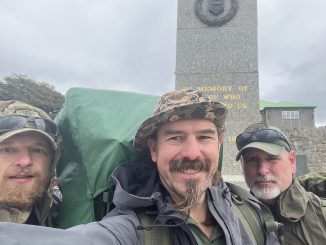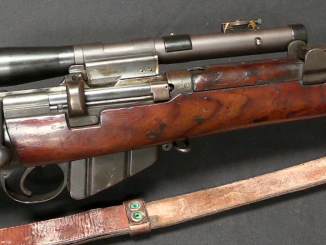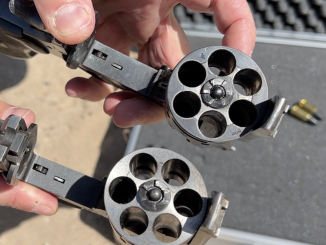This rifle is coming up for sale at RIA on June 23.
The British military started using training rifles in 1883, with the .297/.230 Morris cartridge in adapted Martini rifles. This would give way to the .22 rimfire cartridge for training shortly after the Boer War, and a substantial variety of rifles converted to .22 rimfire. Standardization would take until 1921, when the “Rifle, short, .22 inch, RF, Mk IV” was formally adopted – a conversion of the No1 MkIII SMLE to a single shot .22 rimfire weapon. This was modified to Mk IV* in 1925, when an empty magazine body was added to the rifle, to act as a brass catcher.
Just to make things more confusing, the nomenclature system was retroactively changed in 1926, and the designation because Rifle, No2 Mk IV*. This rifle is a very simply conversion. It used a standard bolt body, with the striker and bolt head modified for a rimfire type firing pin and .22 caliber extractor. The sight was not even changed; instead a conversion chart was issued with the rifles to specify the proper sight settings for .22 rimfire shooting (ie, set sight to 300yd for shooting at 25yd). These rifles would be used into the 1950s, particularly by India and Australia, who did not produce No4 rifles and thus did not produce No4 trainer conversions either.




where is the link to Rock Island Auction?
Immediately below movie (This rifle is coming up…)
“shortly after the Boer War”
Moreover, if I understand correctly bold-italic text here:
http://www.rifleman.org.uk/Society_of_Miniature_Rifle_Clubs.htm
it was answer to lacking marksmanship in British forces during South African War (I do not know if this meant 2nd or 1st Boer War)
The problem with drafting people during wartime is the fact that nobody picked at random is guaranteed to possess great aiming skills. Having “civilian grade” rifle clubs increases likeliness of getting soldiers proficient in shooting much more quickly when the drafting begins. I could be wrong.
I can tell you how it worked in A-H empire and I would expect it would be same in Britain. Young men of certain age and onward were called to regular training in time of peace, way before hostilities broke off. Very similar was the situation two generations later in my time. Different regimes, but very similar idea. Every healthy man in area of central Europe knew not just discipline drills and march but also how to aim and pull trigger.
Generally level of military training is proportional to perceived danger, see for example: http://www.businessinsider.com/what-its-like-south-korea-mandatory-military-service-2017-5?IR=T
however bold-italic text in previous link is interesting insight in British culture at dawn of 20th century, it shows that implementation of sporting shooting of small-bore rifle was done in accordance with said culture and with motivation by rivalry in mind.
It is interesting to compare various military-related sports, which in fact were present yet in ancient times (see: Hoplitodromos):
Biathlon – IIRC originates from Norway, combination of skiing and shooting, missing target means added time, fastest win, it should be noted that unlike some other shooting sport, there are only 2 possible states during shooting: target hit or target missed
Waffenlauf – it is Swiss sport, it is just running, but with requirement of using uniform and carrying service rifle
Tank biathlon – Russian sport: https://en.wikipedia.org/wiki/Tank_biathlon
Field Marshall Lord Roberts encouraged the setting up of Rifle Clubs shooting “Miniature Rifles” to improve marksmanship after the second Boer War, in answer to the perceived superior ability of the Boer. The War Office miniature rifle, Martini Henry conversion, Martini Cadet and the BSA Scout & Cadet rifles all date from this period in a variety of calibers such as .297/230, .220 (.22Lr) and .310.
I have an old No.IV Enfield rifle that was sporterized with a cut down stock and barrel when I got it. I built a single shot carbine in .32 H&R Magnum out of it and did the same trick with the magazine to catch my brass for reloading. And here I was thinking I was sooooo smart coming up with that idea — LOL!!!
As you may note this rifle is marked on the Knoxform NZ. New Zealand received some of these rifles from Britain and also converted their own,in the 1920s these are marked IV* NZ on the left side of the butt socket. NZ used the SMLE until the end of WWII although the No 4 was introduced on an ad hoc basis from 1942 after the war they received an shipment of about 55,000 No 4s from Britain. By far the most common No 4s in NZ are Long Branch and Savage in the ration of 2 to 1.
We had these in Canada as well. Our Army Cadet regiment had several, as well as more of the later models.
These older models were considered to be more desirable by their users simply because they looked cooler.
I am not 100% sure this was the model I shot, but it may be so. It was pretty antique piece – stark in comparison with my new Savage. It did not perform very well (maybe I was part of it), bore was probably neglected. Over all little awkward piece, but it has to but viewed with space of time in mind.
I used this model trainer in my Tasmanian High School Cadet Unit from 1972 -1974. In my naval service I witnessed the final removal from service with Naval Cadet Units in 1988. Some where sold to service members for $50 (AUS) until a media bun-fight saw the practice cease and War reserve stocks of SMLE rifles exported to the USA. I understand that more recently a similar sell off of NZ trainer rifles occurred with a ballot used to acquire.
SMLE Mk IV* frequently turn up in auctions in NZ. A few years ago the NZ Defence Force sold off all their remaining stocks of No 8 & 9 training rifles, which had been surplussed by the Cadet Force, by auction to collectors and shooting clubs, individuals were allowed to purchase one of each and clubs up to 3. Now they are tuning up at auctions. Provided they are kept in good condition all shoot really well.
There was an English tradition of some pubs having rifle ranges for small calibre rifles, and later air rifles in Birmingham (see below). They seem to be concentrated in particular areas, with bell target shooting being popular still in Devises and parts of Hereford for instance; but I cannot find a single source giving an overall history of small bore rifle shooting in pubs.
http://www.historywebsite.co.uk/articles/belltarget/bt01.htm
Hi Ian, can the conversion chart be found to use these sights with the 22lr?